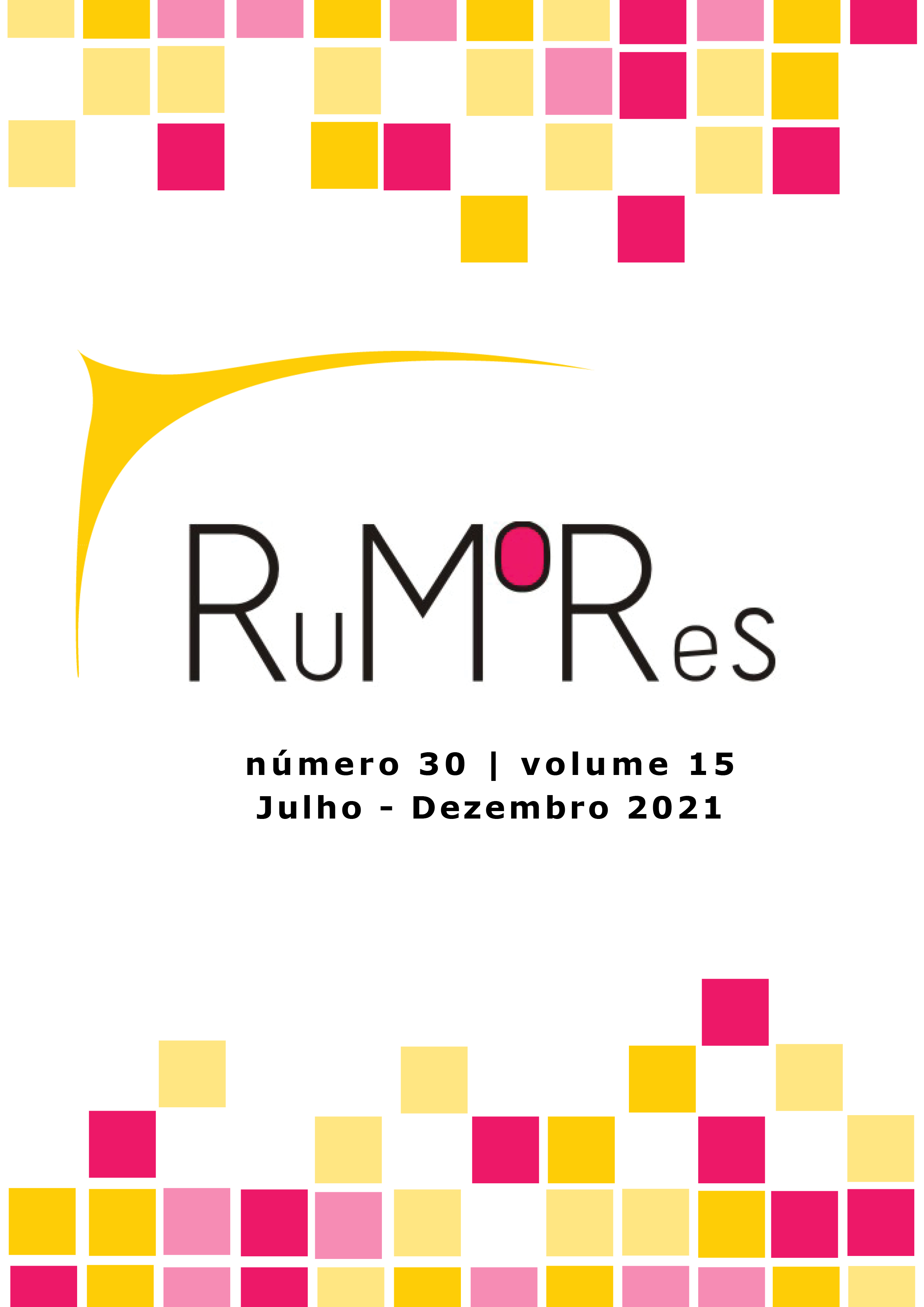Representation of outsiders in Stranger than Paradise
DOI:
https://doi.org/10.11606/issn.1982-677X.rum.2021.175897Keywords:
Established-outsiders, Jim Jarmusch, Stranger than ParadiseAbstract
This article aims to analyze the film Stranger than Paradise (1984), by the American filmmaker Jim Jarmusch. We propose to reflect on the fact that throughout the 20th century “model images”) of the American way of life constituted one of the several American configurations of established-outsider relationships, with the support of the media and the cultural industry. Thus, we will mainly base the study of Strangers in Paradise on the conception of outsiders. We will start from the question: how does the film Stranger than Paradise shows a critical representation of the established-outsider relationships established by the American Way of Life?
Downloads
References
ANDREW, G. Stranger than Paradise: Maverick film-makers in recent American cinema. Nova York: Limelight, 1999.
AUMONT, J.; MARIE, M. A análise do filme. Lisboa: Texto & Grafia, 2009.
BECKER, H. Outsiders: estudos de sociologia do desvio. Rio de Janeiro: Zahar, 2009.
COELHO, P. Desconstruindo a Beleza americana: discursos sobre família no cinema. Domínios da Imagem, Londrina, v. 8, n. 15, p. 98-122, 2014.
COLLINS, P. H. Aprendendo com a outsider within. A significação sociológica do pensamento feminista negro. Revista Sociedade e Estado, Brasília, DF, v. 31, n. 1, p. 99-127, 2016. DOI: https://doi.org/10.1590/S0102-69922016000100006.
COMOLLI, J. L. O espelho de duas faces. In: YOEL, G. (org.). Pensar o cinema: imagem, ética e filosofia. São Paulo: Cosac Naify, 2015. p. 165-203.
COOPER, M. Family values: between neoliberalism and the new social conservatism. Nova York: Zone Books, 2017.
CORRÊA, L. J. A. Breve história do videoclipe. CONGRESSO BRASILEIRO DE CIÊNCIAS DA COMUNICAÇÃO DA REGIÃO CENTRO-OESTE, 8., 2007, Cuiabá. Anais […]. Cuiabá: Intercom, 2007. p. 1-15. Disponível em: https://bit.ly/3ILaJZP. Acesso em: 9 dez. 2021.
CUNHA, P. R. F. American way of life: representação e consumo de um estilo de vida modelar no cinema norte-americano dos anos 1950. 2017. Tese (Doutorado em Comunicação e Práticas de Consumo) – Escola Superior de Propaganda e Marketing, São Paulo, 2017.
DARDOT, P.; LAVAL, C. A nova razão do mundo: ensaio sobre a sociedade neoliberal. São Paulo: Boitempo, 2016.
DELEUZE, G. A imagem-tempo. São Paulo: Brasiliense, 1990.
DUNKER, C. I. L. A lógica do condomínio ou: o síndico e seus descontentes. Leitura flutuante. Revista do Centro de Estudos em Semiótica e Psicanálise, São Paulo, v. 1, p. 1-8, 2011.
ELIAS, N.; SCOTSON, J. Os estabelecidos e os outsiders: sociologia das relações de poder a partir de uma pequena comunidade. Rio de Janeiro: Jorge Zahar, 2000.
FRÚGOLI JR., H. Celebration: a busca da cidade perfeita e a vida real. EURE, Santiago, v. 27, n. 81, p. 123-127, 2001.
HARVEY, D. O neoliberalismo: história e implicações. São Paulo: Loyola, 2008.
HOBSBAWM, E. Era dos extremos: o breve século XX: 1914-1991. São Paulo: Companhia das Letras, 1995.
JARVIS, B. “You’ll never get it if you don’t slow down, my friend”: towards a rhythm analysis of the everyday in the cinema of Jim Jarmusch and Gus Van Sant. Journal of American Studies, Cambridge, v. 54, n. 2, p. 385-406, 2019. DOI: https://doi.org/10.1017/S0021875818001421.
KARNAL, L. História dos Estados Unidos: das origens ao século XXI. São Paulo: Contexto, 2007.
KING, G. American Independent Cinema. Nova York: I. B. Tauris, 2005.
LACKEY, E. Arbitrary reality: the global art cinema of Jim Jarmusch. 2012. Dissertação (Mestrado em Artes) – University of Kansas, Kansas, 2012.
LIEVEN, A. America right or wrong: an anatomy of american nationalism. Nova York: Oxford University Press, 2004.
MCKNIGHT-TRONTZ, J. This ain’t no disco: new wave album covers. São Francisco: Chronicle Books LLC, 2005.
MIGLIORE, R; MOUSINHO; L. Outsiders na telona: alteridade e dialogismo em ghost dog e no cinema de Jim Jarmusch. ANIMUS – Revista Interamericana de Comunicação Midiática, Santa Maria, v. 18 n. 38, p. 111-129, 2019.
MORAN, I. P. Punk: the do-it-yourself subculture. Social Sciences Journal, Danbury, v. 10, n. 1, p. 58-65, 2010.
NEIBURG, F. Apresentação à edição brasileira. In: ELIAS, N.; SCOTSON, J. Os estabelecidos e os outsiders: sociologia das relações de poder a partir de uma pequena comunidade. Rio de Janeiro: Jorge Zahar, 2000. p. 7-12.
ORTNER, S. B. Not Hollywood: independent film at the twlight of the American dream. Londres: Duke University Press, 2013.
RANCIÈRE, J. A partilha do sensível. São Paulo: Editora 34, 2009.
RANCIÈRE, J. As distâncias do cinema. Rio de Janeiro: Contraponto, 2012.
RANCIÈRE, J. O espectador emancipado. São Paulo: Martins Fontes, 2012a.
ROOPNARINE, L. United States Virgin Islands migration. Social and Economic Studies, v. 57, n. 3/4, p. 131-156, 2008. São Francisco: Chronicle Books LCC, 2005.
SKLAR, R. História social do cinema americano. São Paulo: Cultrix, 1975.
WALLERSTEIN, I. European Universalism: the rhetoric of power. Londres: New Press, 2006.
WOODWARD, K. Identidade e Diferença: uma introdução teórica e conceitual. In: SILVA; T., HALL, S; WOODWARD, K. (org.). Identidade e diferença: a perspectiva dos estudos culturais. Rio de Janeiro: Vozes, 2000. p. 2-43.
WYNTER, S. Unsettling the coloniality of being/power/truth/freedom towards the human, after man, its overrepresentation – an argument. The New Centennial Review, East Lansing, v. 3, n. 3, p. 257-337, 2003. DOI: https://doi.org/10.1353/ncr.2004.0015.
Downloads
Published
Issue
Section
License
Copyright (c) 2021 Helena Lukianski Pacheco , Melina Aparecida dos Santos Silva

This work is licensed under a Creative Commons Attribution-NonCommercial-ShareAlike 4.0 International License.
Declaro a total e irrestrita cessão de direitos autorais sobre o texto enviado para publicação na Rumores – Revista Online de Comunicação, Linguagem e Mídias. Entendo que o conteúdo do artigo é de minha inteira responsabilidade, inclusive cabendo a mim a apresentação de permissão para uso de imagens, ilustrações, tabelas, gráficos de terceiros que, porventura, venham a integrá-lo.









